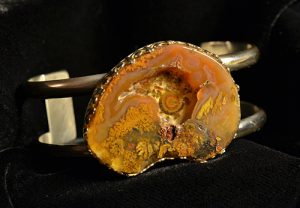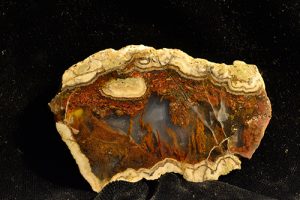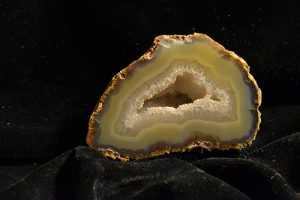
Story and Photos by John L. Carver
It has been called “the most diverse, colorful and unique agate find in far west Texas since the early l960s”. Is it hype? Is it overstatement? Is it factual? What is behind it? While west Texas has long been famous for agate fields and finds, the above-quoted observation by rock enthusiast Bill Halepeska demands credibility in that it is based upon his lifetime of professional work as a geologist and over 50 years of rock collecting in a great many of the west Texas agate fields. Halepeska’s observation also invites evaluation.
I have spent the last eight years documenting and researching a deposit that I have named the Carver agate field. This is a sort of progress report on the fieldwork and lapidary work that I have undertaken, which are ongoing. The new agate field is located in the hills above Alpine, Texas, in the west Texas mountains, a highly volcanic area.
While the volcanism, according to Halepeska, is ancient, it is evident all around Alpine, in formations such as the Twin Peaks that loom over Alpine, and the Paisano volcano on the outskirts of Alpine, which is the remains of an ancient supervolcano. U.S. Highway 67/90 and the railroad run west from Alpine through the actual caldera of the supervolcano. The road cuts show lava, breccia, and volcanic ash (tuff) in multiple colors.
All of this can be seen from the highway upon leaving Alpine heading west, toward Marfa, Texas. This area is a must-see if you like rocks and are into volcanoes.
While the entire Alpine area displays ancient limestone bedding overlain by more recent volcanism, with both layers cut through by deep erosion, the volcanic formations of the Carver are, according to Halepeska, the result of a large number of volcanic episodes over a long period of time. Geologically, Halepeska says, each volcanic event will generally have its own mineral signature in ash and\or lava. Ancient volcanic activity was responsible for the formation of most of the renowned west Texas agate fields. Having said that, however, not all volcanic activity has yielded agates, nodules and\or geodes. In fact, close inspection of U.S. Highway 67\90 though the Paisano volcanic caldera shows no sign of agate, geodes or nodules.
The Carver agate field overlooks the Paisano volcanic activity, but appears to have a very different, and perhaps unique, geological history that has resulted in, as Halepeska says, “the most diverse, colorful and unique agate find in far west Texas since the early l960s”.
So what makes the Carver agate field so unusual? What has caused this extraordinary diversity of agate materials?
1. Amygdaloidal geodes and nodules
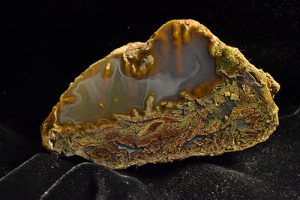
Geodes are found in the Carver with much greater frequency than has been usual in other west Texas agate fields Halepeska has visited since the early 1960s. Geodes and nodules form in cavities that result from gas bubbles trapped within solidifying lava through the introduction of solutions that are high in silica, with other mineralization. The geode or nodule takes the shape of the void in which it forms. Amygdaloidal (almond-shaped) geodes, for instance, tend to be flattened on the bottom.
If there is adequate silica, the void fills completely and a solid nodule results. If there is insufficient silica, the void only partially fills, forming a geode. In a typical geode, there is a lining of agate on the walls of the void. Crystals of various minerals, most often euhedral quartz, form atop this lining, and the center remains unfilled.
Endless Variety of Color
The color variety in the geodes and nodules of the Carver is almost endless, including white, clear, beige, yellow, orange, red, purple (amethyst), blue, green, brown, dark amber, black, and a great many pastel shades. Halepeska says green is a very rare color for west Texas geodes and nodules. Amethyst geodes and agates have also been found in the Carver, and appear to be quite rare, but not unheard of, in west Texas.
In addition to an amazingly broad color spectrum, the Carver geodes and nodules often contain a vast amount of mineralization, inclusions, and sagenitic material. Common names for the agate types found in the Carver include dendritic agate, orbicular agate, tubular agate, eye agate, fortification agate, plume agate, membranous agate, moss agate in red, green, orange, yellow, and combinations thereof, and scenic agate. Many have zeolites (needlelike crystals with a starburst appearance), escape tubes, crystal pseudomorphs, crystal molds, and spherulite (feldspar in quartz) inclusions. Many nodules and geodes contain nameless sagenitic material, as well as shards of lava and jasper. These materials add to the color range, giving many specimens an unusual or unique look and color.
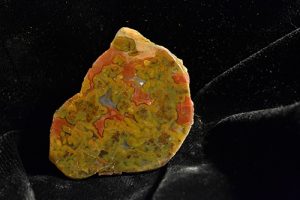 Halepeska, judging from his over 50 years of collecting experience in west Texas, says that the broad range of color and appearance is extremely unusual within a single agate field. This leads him to conclude that the Carver is the most unique and diverse field he has observed in west Texas since the early 1960s. To support this conclusion, he notes that most experienced west Texas rock collectors can look at an agate from the region and identify the specific ranch or location in which it was found.
Halepeska, judging from his over 50 years of collecting experience in west Texas, says that the broad range of color and appearance is extremely unusual within a single agate field. This leads him to conclude that the Carver is the most unique and diverse field he has observed in west Texas since the early 1960s. To support this conclusion, he notes that most experienced west Texas rock collectors can look at an agate from the region and identify the specific ranch or location in which it was found.
There are general appearance characteristics that are common to many of the west Texas agate fields. Such is also the case with other well-known agate sources, such as Deming and Laguna, New Mexico, the Lake Superior region, and Woodward Ranch, Texas. There is, however, no similarity of appearance among the rocks of the Carver. They are more different than alike.
Gordie Sanborn, a long time Alpine lapidary and rock collector, upon seeing the cut and polished specimens from the Carver, incredulously inquired, “Is this all from here?” When told that what he was seeing was all from the Carver, he said that he was expecting that the collection had been gathered from around the world. Sanborn has camped at the famed Woodward Agate Ranch and collected there for many weeks. In short, he apparently found the diversity and color of agate from the Carver to exceed what he had experienced after extensive collecting on the Woodward.
2. Vein agates
In addition to geodes and nodules, the Carver contains much vein agate, which results from solutions flowing into rock fractures and depositing silica and other mineralization to form agate within the fracture. An example could be a fortification agate. The color range and types of inclusions within the vein agate of the Carver is extremely broad and variable.
3. Agatized breccia
The Carver contains agatized breccia, e.g., shards of fractured bedrock (lava) and\or fractured agates and jaspers (jasp-agate) that have been recemented by the reintroduction of silica and other mineralization. This new agate seals the cracks and fractures in the breccia.
4. Jasper and jasp-agate
There is a large amount of multicolor jaspers and jasp-agate in the Carver,
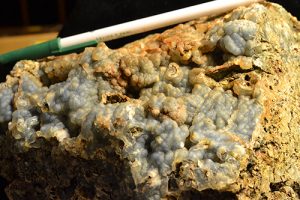
commonly red, orange, yellow, green, brown and black, that in many cases has been agatized and\or has been fractured or re-cemented by silica and further mineralization. Are these jaspers, agatized jaspers, or agates? We can debate the terminology, but not the incredibly colorful and diverse material that has resulted from the unique geology of the Carver.
5. Irregular nodules
Additionally, there are heavily weathered (usually small) irregularly shaped nodules and agates with weathered exteriors that resemble coral or exfoliated white-yellow quartz rinds. When cut and polished, these offer up an endless array of colors, patterns, mineralization, and beautiful petite agatization.
6. Druzy
The Carver has also yielded multicolor druzy in which blue and red are the most common colors. Druzy most often forms within voids in geodes or agate veins. Related to the druzy, but of different appearance and formation, is a recently discovered, very large, collapsed pocket containing spectacular crystallization secondary to what may be either pisolite or tube agate within the pocket. The coloration is reddish. The collapsed pocket was recovered in more than 16 plates or pieces, mostly pristine and undamaged. The sizes of the pieces range from 3 inches by 3 inches to 16 inches by 6 inches, with many in the 5-inch by 10-inch range. This is the most recent find, and the only find of its type, in the Carver.
While further research will be required to unlock all the mysteries of the Carver agate find, some preliminary conclusions can be made about how the geological environment produced an unusually diverse agate field. Several conditions must have been met for the Carver to exist. First, the presence of molten lava containing large and small gas bubbles was necessary.
These bubbles created voids in the solidified lava, into which silica and other mineralization—the nodules, geodes and agates from the Carver contain a mind-blowing number and variety of inclusions and sagenitic materials—could be deposited. Many lavas contain no gas bubbles and, resultantly, no nodules or geodes.
Evidence Within the Earth
Second, well-drilling activity on the Carver agate field has produced evidence of the stacking, or layering, of volcanic lava and volcanic ash. Well-drilling data shows that up to 800 feet of stacking still remains in places, even after millions of years of erosion.
Third, surface water or groundwater, Halepeska believes, was necessary to dissolve and transport silica and mineralization from the lava and volcanic ash into the voids in the lava. It is believed that water was essential to complete the creation of nodules, geodes, and vein agates contained within this formation.

Fourth, the bedding of ash, lava, and other mineralization created a varicolored matrix that is believed to be unique in west Texas within a single agate field. Likewise, the mineralization available in solution produced an extremely diverse array of colors, inclusions, and sagenitic materials in the nodules, geodes and agate formations.
Fifth, the diversity of the material found in the Carver is also a result of where and how much erosion has occurred. In other words, if erosion has not exposed the volcanic level containing the gas bubbles, no geodes or nodules will be found.
A sixth geological factor is that many of the nodules, agates and geodes, as well as agatized jaspers and vein agates, in the Carver display significant fracturing of both the lava matrix and the silica material in the lava voids. Some lava shards and pieces of fractured nodules, agates or geodes have been recemented by solutions flowing into the fractured material and depositing additional silica and other mineralization.
Diversity Among Geological Gifts
The reintroduction of silica into cracks and voids likely increased the diversity and range of colors found within the geodes, nodules and agates of the Carver. Halepeska believes that repeated eruptive activity was the likely cause of the fracturing, healing (by silica), and refracturing process. Multicolor ash layers sandwiched between lava layers produced the silica for the cementing and recementing of the fractured agate material and the diverse coloration.
While the Carver field contains many silica nodules and a significantly high number of geodes, combined with a vast range of color, sagenitic materials, and inclusions, many areas of the field contain nothing at all of interest. Significant areas contain nodules and geodes with little or no color or interesting inclusions. Within the field, while agates can be found anywhere, they are not found everywhere.
From the geological evidence, I conclude that Halepeska’s opinion concerning the diversity of the Carver agate field is not hype or hyperbole. The uniqueness of the field is the diversity and variability of the material found in it. My eight years of fieldwork and lapidary processing have resulted in more than 1,000 cut and polished specimens, which document the field’s extraordinary geological diversity.
During these eight years, I have not sold any rock from the Carver except that set in sterling silver bracelets, which I occasionally make to display its diversity. My collection is still 100% complete (and growing), and is available for viewing as part of serious research.
The Carver is on private land, and while I have collected rocks for over 60 years and I really enjoy seeing collectors experience the thrill of the find, it unfortunately is not open to collecting. For me, it has been like eight years of Christmas mornings. I hope you can vicariously enjoy my find on my Web site, www.TexasAmethystAgate.com, where extensive photo galleries illustrate the diversity and beauty of the material from the Carver. Gem Show Gallery 1 and the Bracelet galleries are good places to see the diversity of the material from the Carver. Ultimately, the viewer can be the judge of the Carver find’s diversity, color and uniqueness.
You are welcome to leave a comment or contact me through my Web site; I would be interested in hearing what you think.


